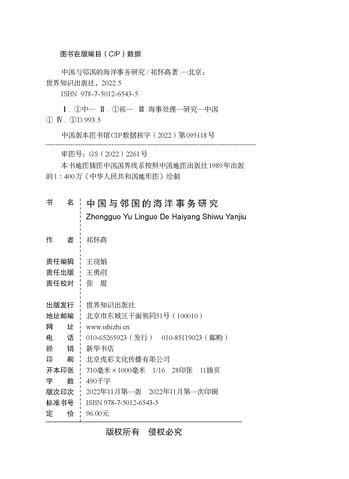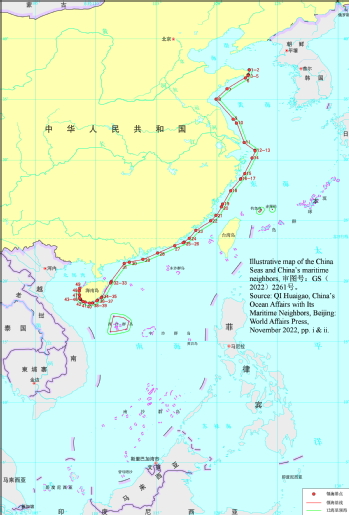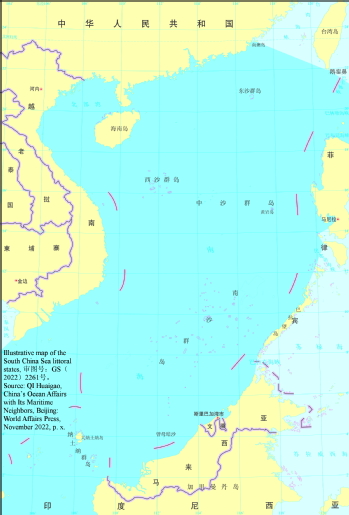QI Huaigao, China’s Ocean Affairs with Its Maritime Neighbors, Beijing: World Affairs Press, November 2022.
ISBN:978-7-5012-6543-5
|
|
The title page of China’s Ocean Affairs with Its Maritime Neighbors | The copyright page of China’s Ocean Affairs with Its Maritime Neighbors |
The Book, China’s Ocean Affairs with Its Maritime Neighbors, mainly focuses on China’s ocean affairs with its 8 maritime neighbors, namely DPRK, ROK, Japan, Vietnam, the Philippines, Malaysia, Brunei, and Indonesia. The main content of the Book includes an analysis on claims to maritime jurisdiction, on marine fisheries relations, on joint development of oil/gas resources, on territorial dispute, on maritime delimitation, and on practical maritime cooperation of China and its maritime neighbors, etc. While firmly safeguarding its territorial sovereignty and maritime rights and interests, China has actively carried out practical maritime cooperation with its maritime neighbors in the context of building China into a maritime power. The Book mainly discusses three ways to settle the maritime disputes between China and its maritime neighbors. The first way is to move steadily forward negotiations on maritime boundary delimitation, the second way is to move actively forward on joint development and marine fisheries management, and third way is to manage Sino-U.S. maritime competition in the Western Pacific. The Book, illustrated with 10 color maps and 27 black-and-white maps, balances technicality and readability in content.
Dr. QI Huaigao is a Professor of International Relations at the Institute of International Studies, Fudan University (IIS Fudan). His major research areas are China’s neighboring diplomacy, China’s ocean affairs, Asia Pacific international relations, international organization, and global governance. He received a Ph.D. in World History from Wuhan University in June 2007. He was a Post-Doctoral Fellow in Political Science at Fudan University’s School of International Relations and Public Affairs from July 2008 to September 2010, a Rajawali Fellow of Ash Center for Democratic Governance and Innovation at Harvard University’s Kennedy School of Government from January 2013 to December 2013, and a Swire Scholarship Academic Visitor at St Antony’s College, University of Oxford from October 2017 to September 2018. Dr. Qi has served as Vice Dean of IIS Fudan since November 2017, and has been promoted to Professor by Fudan University in December 2020.
Contents
List of maps, figures, and tables……1
Inset maps……i/ii
Introduction: China’s maritime jurisdiction and its recent relations with maritime neighbors
I. China’s maritime rights and interests and its jurisdiction claims……1
II. China’s maritime affairs with its maritime neighbors……13
III. China Taiwan’s claims to maritime rights and interests……18
IV. The characteristics and framework of this Book……26
Chapter One: China’s maritime affairs with the DPRK in the Yellow Sea
I. DPRK’s claims to maritime jurisdiction……30
II. Maritime boundary delimitation Between DPRK and USSR……35
Summary……38
Chapter Two: China’s maritime affairs with the ROK in the Yellow Sea and East China Sea
I. ROK’s claims to maritime jurisdiction……39
II. Maritime delimitation negotiation Between China and ROK……44
III. Analysis of the Sino-ROK Fishery Agreement……57
Summary……61
Chapter Three: China’s maritime affairs with Japan in the East China Sea
I. Japan’s claims to maritime jurisdiction……64
II. Territorial dispute of the Diaoyu Island and its affiliated islands Between China and Japan……74
III. The delimitation of EEZs and CSs Between China and Japan in the East China Sea……84
IV. The Sino-Japanese Fishery Agreement and joint development in the East China Sea……94
Summary……106
Chapter Four: China’s maritime affairs with the Philippines in the South China Sea
I. Philippine claims to maritime jurisdiction……109
II. Territorial disputes of some islands and reefs of Nansha Qundao and Huangyan Dao Between China and the Philippines……119
III. The Award of the South China Sea Arbitration and its influence……126
IV. China–Philippines joint development in the South China Sea: obstacles and remedies……129
Summary……143
Chapter Five: China’s maritime affairs with Malaysia in the South China Sea
I. Malaysia’s claims to maritime jurisdiction……147
II. Territorial disputes of some islands and reefs of Nansha Qundao Between China and Malaysia……156
III. Prospects for Sino-Malaysian joint development in the South China Sea……159
Summary……167
Chapter Six: China’s maritime affairs with Brunei in the South China Sea
I. Brunei’s claims to maritime jurisdiction……170
II. The settlement of maritime boundaries Between Brunei and Malaysia……175
III. China–Brunei maritime cooperation in the South China Sea……181
Summary……185
Chapter Seven: China’s maritime affairs with Indonesia in the South China Sea
I. Indonesia’s claims to maritime jurisdiction……187
II. Overlapping claims to maritime jurisdiction Between China and Indonesia……203
III. Indonesia strengthens its claimed sovereignty rights in the waters near the Natuna Islands……214
IV. China–Indonesia maritime cooperation in the South China Sea……219
Summary……224
Chapter Eight: China’s maritime affairs with Vietnam in the South China Sea
I. Vietnam’s claims to maritime jurisdiction……226
II. Sino-Vietnamese Boundary Agreement and Fishery Agreement……234
III. Sino-Vietnamese disputes in the South China Sea and analysis on Vietnam’s claims……242
IV. Peaceful solution to Sino-Vietnamese disputes in the South China Sea……247
Summary……251
Chapter Nine: China’s presence and challenges in the South China Sea
I. The presence of China in the South China Sea. ……256
II. The challenges for China in the South China Sea……262
Summary……268
Chapter Ten: China’s incentives and policy choices on joint development in the South China Sea
I. China’s economic incentives and strategic incentives on joint development in the South China Sea……272
II. China’s policy choices on joint development in the South China Sea……277
Summary……289
Chapter Eleven: Regime integration of multilateral non-traditional security cooperation in the South China Sea
I. The challenges for non-traditional security and the obstacles for multilateral cooperation in the South China Sea……293
II. Analysis on the South China Sea multilateral security initiatives by three actors……300
III. Established institutions on multilateral non-traditional security cooperation in the South China Sea……307
IV. Basis and principles on regime integration of multilateral non-traditional security cooperation in the South China Sea……316
Summary……323
Conclusion: The future settlement of maritime disputes Between China and its maritime neighbors
I. Moving steadily forward negotiations on maritime boundary delimitation……325
II. Moving actively forward on joint development and marine fisheries management……330
III. Managing Sino-U.S. maritime competition in the Western Pacific……338
Bibliography
Chinese references……346
English references……360
Acknowledgements……388
Index……398
Map 0–1: Illustrative map of the China Seas and China’s maritime neighbors | Map 9–1: Illustrative map of the South China Sea littoral states |
|
|
审图号:GS(2022)2261号。 | 审图号:GS(2022)2261号。 |
|
|
The publication of China’s Ocean Affairs with Its Maritime Neighbors was made possible through a generous grant from Fudan University Gaofeng & Gaoyuan Project, and Asia Research Center of Fudan University.
The Book, China’s Ocean Affairs with Its Maritime Neighbors, is the 11th book in Fudan University Series on China’s Neighboring Diplomacy Studies.
Fudan University Series on China’s Neighboring Diplomacy Studies is the publication project supported by the Center for China’s Relations with Neighboring Countries of Fudan University (CCRNC Fudan).










